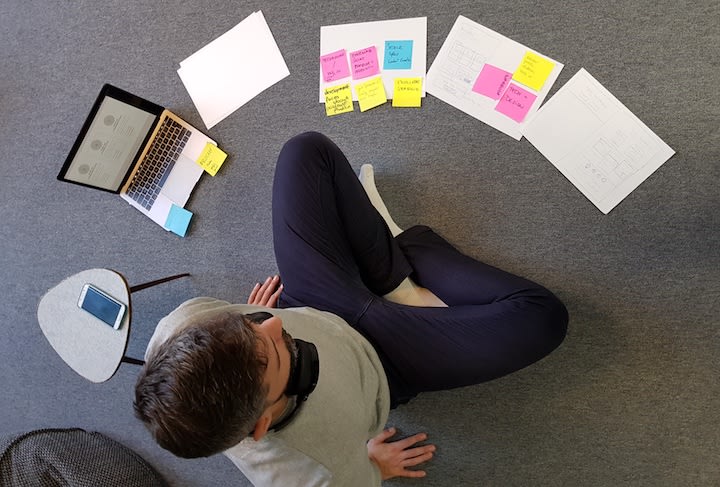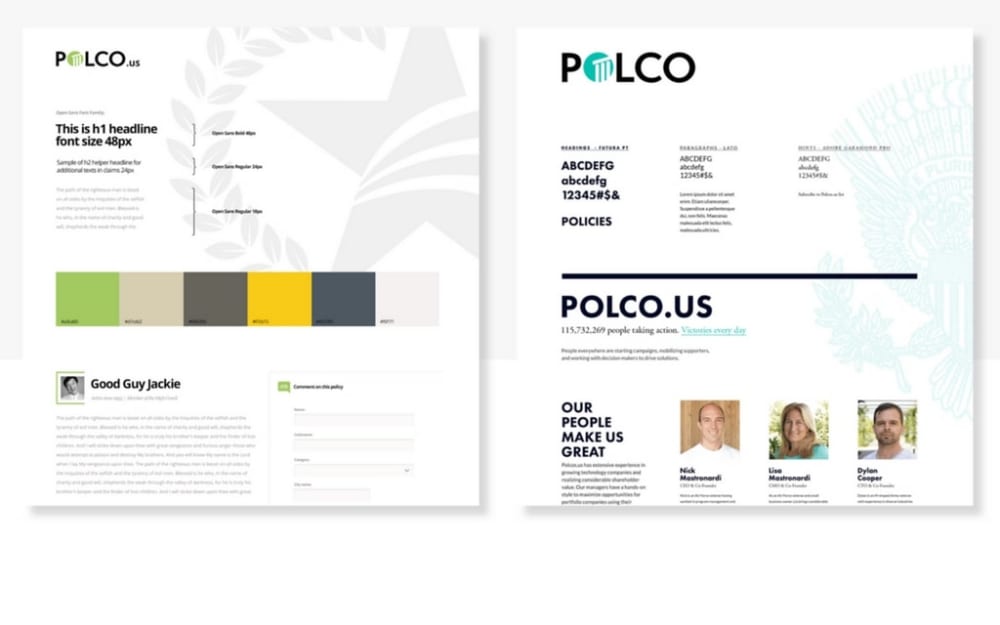What Is Design Thinking?
The phrase ‘design thinking’ has been around for decades. It has evolved to represent a framework approach to creative problem-solving with an emphasis on practical solutions. Well-suited to digital product development, it’s a natural choice for Boldare.

Table of contents
Design thinking is here to stay. And with Forrester-IBM research finding that it can reduce design and development time by up to 75%, it’s no wonder. Teams that utilize design thinking methodology also cut costs, manage risk better, produce better quality products, and boost profitability. Some have cited increases in ROI of 300+%. What is design thinking?
Design thinking - definition & meaning
The term was first coined in the title of the 1987 book, “Design Thinking” by Peter Rowe, who went on to become the dean of Harvard University’s Graduate School of Design. A nutshell definition might be, that design thinking is a process that codifies how a ‘designer-consultant’ would deal with a client’s project, allowing anyone to adopt the same approach.
Clearly, using the design thinking approach does not immediately make you a trained designer, but used on the right project (digital product design, anyone?) it is an effective – and creative – method of achieving results. But what is a design thinking process exactly?
>> Do you wonder why design matters? Here is the answer
Design thinking is a way to understand the client’s needs (including their users’ needs) in depth, before taking a creative and solution-oriented approach to meeting those needs. Some of the essential characteristics of design thinking include empathy, collaboration, questioning, creativity, exploration, experimentation, and continuous improvement. Sounds good, but what is it?
While definitions of design thinking may vary, depending on the source, the core feature of this approach is the customer. Whatever stage of the design process you’re at, the focus on people – especially the product user – is essential. Without that, it’s just not design thinking.

What is design thinking for?
Design thinking aims unlock creativity in a way that is directly focused on the nub of the ‘problem’ and the needs of those affected by that problem.
The emphasis on people (often referred to as empathy) is intended to lead to more holistic insights than a more traditional approach obsesses with business success, the bottom, and technical/mechanical matters. Not that these issues aren’t relevant, it’s simply that adding people to the mix of factors can lead to a more balanced outcome which is both profitable and sustainable.
>> Read an article about “What are design sprints?”
Design thinking process
The best way to understand the design thinking approach and its applications is to look at the process itself. Though different schools of thought tend to create their own versions of that process, a ‘classic’ 5-phase version comes from Stanford University’s school:
- Empathy – get to know the users.
- Definition – understand what users need, gather insights into the issues underpinning the problem (dig deep enough and almost certainly, the original problem statement is incomplete or oversimplified).
- Ideation –challenge assumptions, storm ideas, give free reign to innovation.
- Prototyping – create a solution that solves at least part of the problem.
- Testing – test the prototype with users and gather feedback.
However, this is not a linear, one-step-after-the-other process. Though these phases work just fine taken in sequence, the reality of creative problem-solving is that these different phases may be happening in parallel, or taken together form just one round or iteration of creative design. Especially when the product is complex, including a number of different features or functions, each of which might be created and tested individually as part of the process.
The benefits of design thinking
Rooted in its alternative perspective on problem-solving, the design thinking methodology offers numerous advantages.
- Focused on the user – The user is at the center of design thinking. The golden thread running through the whole process is the user; their needs, understanding them better, creating a genuine solution to the user’s problem, people first in other words.
- Aimed at understanding – The user focus goes far beyond asking the client what they want their product to do for users. The key to design thinking is to really get inside the end user’s mindset and experience. At their best, a practitioner of design thinking empathizes with the user, identifies with them and therefore invests themselves personally in finding the best possible solution. The process encourages practitioners to be more in touch with people.

- Silo-busting – Traditionally, especially in larger organizations, different roles, disciplines and departments can be segregated, interacting at a bare minimum level; working ‘in silos’. But this process encourages people to break out of those silos and come together around the focus of a specific problem, thus allowing for all kinds of knowledge and experience exchange, giving the project team more resources to apply to creating a solution.
- Community-based – People work together in design thinking. With a mixed group of roles coming together on several occasions to work toward a common goal, there is a direct benefit on the organization and quality of the collaboration (which, of course, spins off into other, future projects).
- An emphasis on the practical – There is nothing hypothetical about design thinking. For it to work, it must be focused on a genuine, real-world issue, specifically aimed at a value-adding solution.
>> Read an interview with Paweł Capaja, a Boldare Product Designer
- Tried and testing – Continuing the practical theme, design thinking includes an actual creation process. Prototypes are put together, often addressing and testing a single feature or facet of a possible solution, resulting in timely feedback which then influences subsequent design and the next test. Due to its non-linear nature, the design thinking process often allows for not only multiple but simultaneous prototypes, encouraging faster working (albeit sometimes chaotic) and a cross-pollination of ideas.
- Continuously improving teamwork – A longer term, internal benefit to organizations using design thinking is that their people become accustomed to operating with concepts such as empathy, putting the user first, and rapid testing of ideas. This systematized exposure to, and exploration of, other people’s needs and experience encourages a mindset of collaboration and open understanding, potentially leading to an upwards spiral of ever-improving teamwork.
- A learning organization – Another theme that should be obvious in design thinking is that it is a learning-focused process. In fact, as a general rule, if the process ever starts to slow down, a good re-ignition strategy is to look for what you don’t yet know about the situation (for users, the client, or yourself) and start asking questions. An organization with learning at the heart of its culture is a creative organization.
Design thinking at Boldare
Design thinking is highly compatible with agile manifesto principles (not the same, but very complementary) and at Boldare we are dedicated to using an agile approach to working with our clients – much of our digital product development rests on the twin pillars of the scrum framework and the lean startup approach.
In this sense, design thinking works well. The rapid process suits our sprint-based style, and the deep understanding of user needs and client business goals is of critical importance in the kick-off and product vision and business canvas workshops we run at the beginning of every project, together with the tools we use for user story mapping and release planning.

In fact, these workshops – often a series of events involving the client’s representatives and the whole Boldare project team – are essentially an intensive kick-starting of the empathy, definition, and ideation stages of design thinking. Led by a Boldare Scrum Master, these events focus on the client and team getting to know each other, ensuring the team understand the problem they are there to solve, and mapping out the future of the project process, including the communication and collaboration between the client organization and Boldare.
Primarily, the goal is the discussion and exchange of information and initial discussion of ideas and potential solutions, leading to the initial version of the Product Backlog, the list of everything - requirements, changes to be made, etc. - needed for the product.
As the old saying goes, “If the only tool you have is a hammer, everything begins to look like a nail.” (generally attributed to psychologist, Abraham Maslow, though alternative versions exist). In other words, if you come at every problem from the same viewpoint, you’ll likely use the same old solutions/strategies every time. But every problem is different…
Design thinking offers a flexible framework which aims to treat the problem as a unique challenge, encouraging you to understand the challenge at hand before you select the appropriate tool (Hammer? Chisel? JavaScript?).
Put another way, design thinking is a method to help you to break free of established problem-solving patterns, enabling you to get out of your comfort zone and instead bring to the table what the problem needs.
Design thinking for better product
Design thinking is a flexible problem-solving process focused on the end user and their requirements. The emphasis on exploration and deeply understanding the challenge ahead – especially from the human angle – before proceeding to the ideation phase. The user perspective is also central to the creation and testing of prototype features and products, ensuring real-world, pragmatic input to the design process. At Boldare, Design Thinking concepts fit closely with our approach to design and digital product development.
Share this article:






